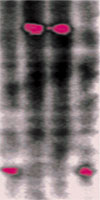Caught you!
 all genetic research begins with isolation of mutants: genes or organisms that appear different from the normal ones (the wild-types). Keith Williams and colleagues from the School of Biological Sciences in Macquarie University, Sydney, Australia, have found a solution known as fluorescence-activated cell sorting (facs) for identifying mutants that differ just a little from the wild-type.
all genetic research begins with isolation of mutants: genes or organisms that appear different from the normal ones (the wild-types). Keith Williams and colleagues from the School of Biological Sciences in Macquarie University, Sydney, Australia, have found a solution known as fluorescence-activated cell sorting (facs) for identifying mutants that differ just a little from the wild-type.
However, the solution works only when the wild-type possesses the protein marker that the mutant lacks. This new technique helps locate such mutants by labelling the wild-type with an antibody joined to a fluorescent probe (a dna fragment marked with a radioactive chemical which helps locate a gene or dna sequence). With this method, a mutant can still be separated even if present in a very small proportion (Cytometry, Vol 25, 1996).
Most mutants tend to be grossly aberrant in appearance or behaviour, so spotting them is usually not a problem. Quite often, they are so aberrant that they die at an early stage of development, making it difficult to experiment with them.
Going by the theory of evolution by natural selection, what we think of as the wild-type today must have arisen as a mutant sometime in the distant past. However, it is clear that aberrant mutants cannot provide (or have provided) the raw material for evolution; they are obviously too
Related Content
- Noisy vehicle silencers will be closed chapter in Bengaluru
- A poison worse than any spill: How a third of fish caught in the English Channel have microplastics in their guts
- Bengaluru civic body will fine you Rs 500 if you're caught with plastic
- First 2 Fugitives from Interpol's Most Wanted Envornmental List Nabbed
- Getting caught with our plants down: the risks of a global crop yield slowdown from climate trends in the next two decades
- World Wetlands Day:Need to save our marshlands and mangroves
